Hi,
thanks for the kind words both from Maxon and the community. I am looking forward to my upcoming adventures with the SDK Team and Cinema community.
Cheers,
Ferdinand
Hi,
thanks for the kind words both from Maxon and the community. I am looking forward to my upcoming adventures with the SDK Team and Cinema community.
Cheers,
Ferdinand
Hello @holgerbiebrach,
please excuse the wait. So, this is possible in Python and quite easy to do. This new behavior is just the old dialog folding which has been reworked a little bit. I have provided a simple example at the end of the posting. There is one problem regarding title bars which is sort of an obstacle for plugin developers which want to distribute their plugins, it is explained in the example below.
I hope this helps and cheers,
Ferdinand
The result:

The code:
"""Example for a command plugin with a foldable dialog as provided with the
Asset Browser or Coordinate Manger in Cinema 4D R25.
The core of this is just the old GeDialog folding mechanic which has been
changed slightly with R25 as it will now also hide the title bar of a folded
dialog, i.e., the dialog will be hidden completely.
The structure shown here mimics relatively closely what the Coordinate Manger
does. There is however one caveat: Even our internal implementations do not
hide the title bar of a dialog when unfolded. Instead, this is done via
layouts, i.e., by clicking onto the ≡ icon of the dialog and unchecking the
"Show Window Title" option and then saving such layout. If you would want
to provide a plugin which exactly mimics one of the folding managers, you
would have to either ask your users to take these steps or provide a layout.
Which is not ideal, but I currently do not see a sane way to hide the title
bar of a dialog. What you could do, is open the dialog as an async popup which
would hide the title bar. But that would also remove the ability to dock the
dialog. You could then invoke `GeDialog.AddGadegt(c4d.DIALOG_PIN, SOME_ID)`to
manually add a pin back to your dialog, so that you can dock it. But that is
not how it is done internally by us, as we simply rely on layouts for that.
"""
import c4d
class ExampleDialog (c4d.gui.GeDialog):
"""Example dialog that does nothing.
The dialog itself has nothing to do with the implementation of the
folding.
"""
ID_GADGETS_START = 1000
ID_GADGET_GROUP = 0
ID_GADGET_LABEL = 1
ID_GADGET_TEXT = 2
GADGET_STRIDE = 10
GADEGT_COUNT = 5
def CreateLayout(self) -> bool:
"""Creates dummy gadgets.
"""
self.SetTitle("ExampleDialog")
flags = c4d.BFH_SCALEFIT
for i in range(self.GADEGT_COUNT):
gid = self.ID_GADGETS_START + i * self.GADGET_STRIDE
name = f"Item {i}"
self.GroupBegin(gid + self.ID_GADGET_GROUP, flags, cols=2)
self.GroupBorderSpace(5, 5, 5, 5)
self.GroupSpace(2, 2)
self.AddStaticText(gid + self.ID_GADGET_LABEL, flags, name=name)
self.AddEditText(gid + self.ID_GADGET_TEXT, flags)
self.GroupEnd()
return True
class FoldingManagerCommand (c4d.plugins.CommandData):
"""Provides the implementation for a command with a foldable dialog.
"""
ID_PLUGIN = 1058525
REF_DIALOG = None
@property
def Dialog(self) -> ExampleDialog:
"""Returns a class bound ExampleDialog instance.
"""
if FoldingManagerCommand.REF_DIALOG is None:
FoldingManagerCommand.REF_DIALOG = ExampleDialog()
return FoldingManagerCommand.REF_DIALOG
def Execute(self, doc: c4d.documents.BaseDocument) -> bool:
"""Folds or unfolds the dialog.
The core of the folding logic as employed by the Asset Browser
or the Coordinate manager in R25.
"""
# Get the class bound dialog reference.
dlg = self.Dialog
# Fold the dialog, i.e., hide it if it is open and unfolded. In C++
# you would also want to test for the dialog being visible with
# GeDialog::IsVisible, but we cannot do that in Python.
if dlg.IsOpen() and not dlg.GetFolding():
dlg.SetFolding(True)
# Open or unfold the dialog. The trick here is that calling
# GeDialog::Open will also unfold the dialog.
else:
dlg.Open(c4d.DLG_TYPE_ASYNC, FoldingManagerCommand.ID_PLUGIN)
return True
def RestoreLayout(self, secret: any) -> bool:
"""Restores the dialog on layout changes.
"""
return self.Dialog.Restore(FoldingManagerCommand.ID_PLUGIN, secret)
def GetState(self, doc: c4d.documents.BaseDocument) -> int:
"""Sets the command icon state of the plugin.
This is not required, but makes it a bit nicer, as it will indicate
in the command icon when the dialog is folded and when not.
"""
dlg = self.Dialog
result = c4d.CMD_ENABLED
if dlg.IsOpen() and not dlg.GetFolding():
result |= c4d.CMD_VALUE
return result
def RegisterFoldingManagerCommand() -> bool:
"""Registers the example.
"""
return c4d.plugins.RegisterCommandPlugin(
id=FoldingManagerCommand.ID_PLUGIN,
str="FoldingManagerCommand",
info=c4d.PLUGINFLAG_SMALLNODE,
icon=None,
help="FoldingManagerCommand",
dat=FoldingManagerCommand())
if __name__ == '__main__':
if not RegisterFoldingManagerCommand():
raise RuntimeError(
f"Failed to register {FoldingManagerCommand} plugin.")
Dear Community,
this question reached us via email-support in the context of C++, but I thought the answer might be interesting for other users too.
The underlying question in this case was how to project points from object or world space into the texture space of an object with UV data. I am showing here deliberately an approach that can be followed both in C++ and Python, so that all users can benefit from this. In C++ one has also the option of using VolumeData and its methods VolumeData::GetUvw or VolumeData::ProjectPoint but must then either implement a volume shader (as otherwise the volume data attached to the ChannelData passed to ShaderData::Output will be nullptr), or use VolumeData:: AttachVolumeDataFake to access ::ProjectPoint. There is however no inherent necessity to take this shader bound route as shown by the example.
Cheers,
Ferdinand
The script has created a texture with red pixels for the intersection points of the rays cast from each vertex of the spline towards the origin of the polygon object. The script also created the null object rays to visualize the rays which have been cast.
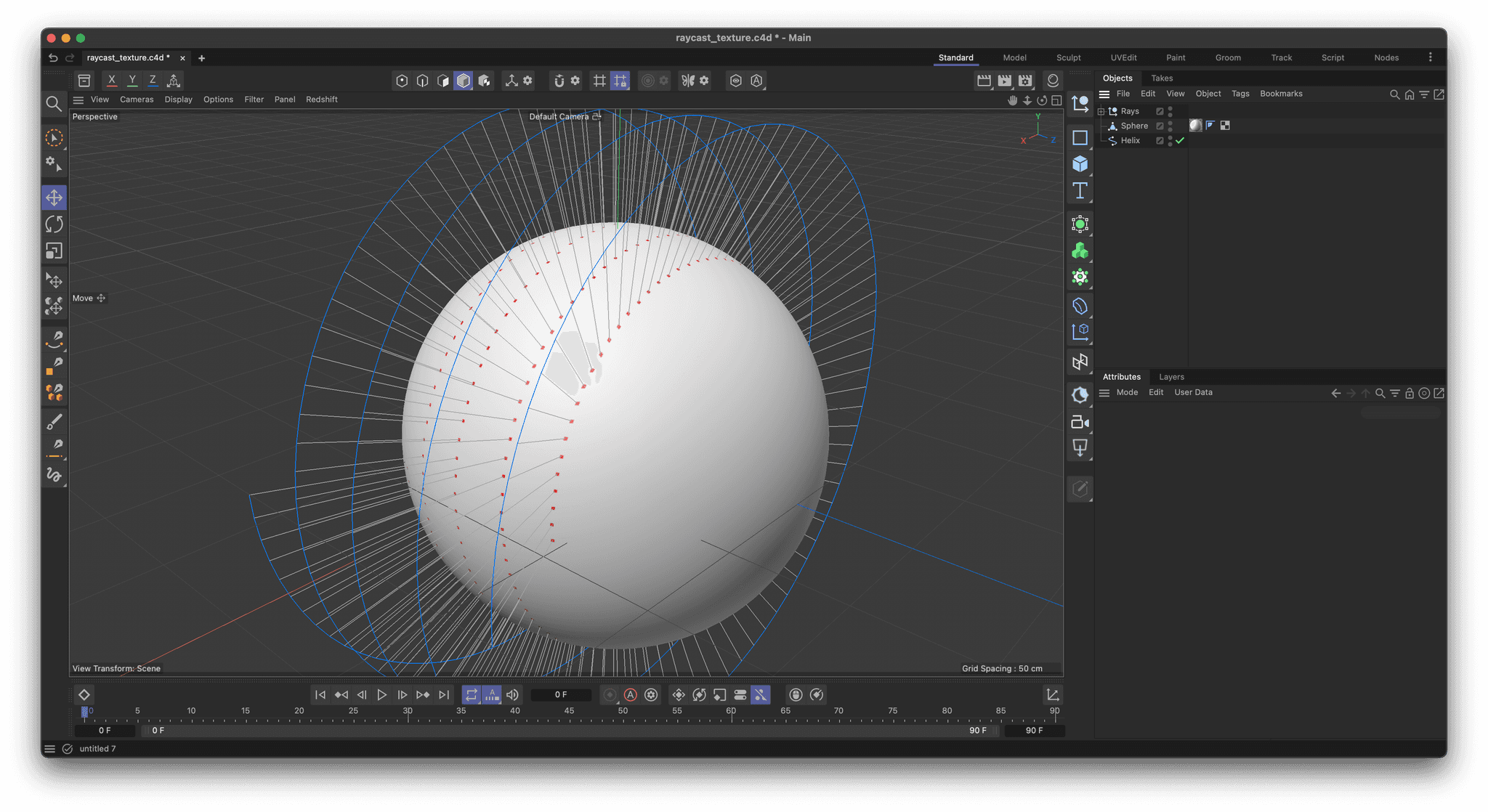
raycast_texture.c4d : The scene file.
You must save the script to disk before running it, as the script infers from the script location the place to save the generated texture to.
"""Demonstrates how to project points from world or object space to UV space.
This script assumes that the user has selected a polygon object and a spline object in the order
mentioned. The script projects the points of the spline object onto the polygon object and creates
a texture from the UV coordinates of the projected points. The texture is then applied to the
polygon object.
The script uses the `GeRayCollider` class to find the intersection of rays cast from the points of
the spline object to the polygon object. The UV coordinates of the intersection points are then
calculated using the `HairLibrary` class. In the C++ API, one should use maxon::
GeometryUtilsInterface::CalculatePolygonPointST() instead.
Finally, using GeRayCollider is only an example for projecting points onto the mesh. In practice,
any other method can be used as long as it provides points that lie in the plane(s) of a polygon.
The meat of the example is in the `main()` function. The other functions are just fluff.
"""
import os
import c4d
import mxutils
import uuid
from mxutils import CheckType
doc: c4d.documents.BaseDocument # The currently active document.
op: c4d.BaseObject | None # The primary selected object in `doc`. Can be `None`.
def CreateTexture(points: list[c4d.Vector], path: str, resolution: int = 1000) -> None:
"""Creates a texture from the given `points` and saves it to the given `path`.
Parameters:
path (str): The path to save the texture to.
points (list[c4d.Vector]): The points to create the texture from.
"""
# Check the input values for validity.
if os.path.exists(path):
raise FileExistsError(f"File already exists at path: {path}")
if not path.endswith(".png"):
raise ValueError("The path must end with '.png'.")
# Create a drawing canvas to draw the points on.
canvas: c4d.bitmaps.GeClipMap = CheckType(c4d.bitmaps.GeClipMap())
if not canvas.Init(resolution, resolution, 24):
raise MemoryError("Failed to initialize GeClipMap.")
# Fill the canvas with white.
canvas.BeginDraw()
canvas.SetColor(255, 255, 255)
canvas.FillRect(0, 0, resolution, resolution)
# Draw the points on the canvas.
canvas.SetColor(255, 0, 0)
for p in points:
x: int = int(p.x * resolution)
y: int = int(p.y * resolution)
x0: int = max(0, x - 1)
y0: int = max(0, y - 1)
x1: int = min(resolution, x + 1)
y1: int = min(resolution, y + 1)
canvas.FillRect(x0, y0, x1, y1)
canvas.EndDraw()
# Save the canvas to the given path.
bitmap: c4d.bitmaps.BaseBitmap = CheckType(canvas.GetBitmap())
bitmap.Save(path, c4d.FILTER_PNG)
c4d.bitmaps.ShowBitmap(bitmap)
def ApplyTexture(obj: c4d.BaseObject, path: str) -> None:
"""Applies the texture at the given `path` to the given `obj`.
"""
CheckType(obj, c4d.BaseObject)
# Check the input values for validity.
if not os.path.exists(path):
raise FileNotFoundError(f"File does not exist at path: {path}")
# Create a material and apply the texture to it.
material: c4d.BaseMaterial = CheckType(c4d.BaseMaterial(c4d.Mmaterial), c4d.BaseMaterial)
obj.GetDocument().InsertMaterial(material)
shader: c4d.BaseShader = CheckType(c4d.BaseShader(c4d.Xbitmap), c4d.BaseShader)
shader[c4d.BITMAPSHADER_FILENAME] = path
material.InsertShader(shader)
material[c4d.MATERIAL_COLOR_SHADER] = shader
material[c4d.MATERIAL_PREVIEWSIZE] = c4d.MATERIAL_PREVIEWSIZE_1024
# Apply the material to the object.
tag: c4d.TextureTag = CheckType(obj.MakeTag(c4d.Ttexture))
tag[c4d.TEXTURETAG_PROJECTION] = c4d.TEXTURETAG_PROJECTION_UVW
tag[c4d.TEXTURETAG_MATERIAL] = material
def CreateDebugRays(spline: c4d.SplineObject, p: c4d.Vector) -> None:
"""Adds spline objects to the document to visualize the rays from the given `p` to the points of
the given `spline`.
"""
doc: c4d.documents.BaseDocument = CheckType(spline.GetDocument(), c4d.documents.BaseDocument)
rays: c4d.BaseObject = c4d.BaseObject(c4d.Onull)
rays.SetName("Rays")
doc.InsertObject(rays)
for q in spline.GetAllPoints():
ray: c4d.SplineObject = c4d.SplineObject(2, c4d.SPLINETYPE_LINEAR)
ray.SetPoint(0, p)
ray.SetPoint(1, q * spline.GetMg())
ray.Message(c4d.MSG_UPDATE)
ray.InsertUnder(rays)
def main() -> None:
"""Carries out the main logic of the script.
"""
# Check the object selection for being meaningful input.
selected: list[c4d.BaseObject] = doc.GetActiveObjects(c4d.GETACTIVEOBJECTFLAGS_SELECTIONORDER)
if (len(selected) != 2 or not selected[0].CheckType(c4d.Opolygon) or
not selected[1].CheckType(c4d.Ospline)):
raise ValueError("Please select a polygon object and a spline object.")
polygonObject, splineObject = selected
# Get the uvw tag, the points, and the polygons of the polygon object.
uvwTag: c4d.UvwTag = mxutils.CheckType(polygonObject.GetTag(c4d.Tuvw))
points: list[c4d.Vector] = [polygonObject.GetMg() * p for p in polygonObject.GetAllPoints()]
polys: list[c4d.CPolygon] = polygonObject.GetAllPolygons()
# We are casting here in a dumb manner towards the center of the polygon object. In practice,
# one should cast rays towards the plane of the polygon object. Or even better, use another
# method to project the points onto the polygon object, as GeRayCollider is not the most
# efficient thing in the world.
rayTarget: c4d.Vector = polygonObject.GetMg().off
CreateDebugRays(splineObject, rayTarget)
# Initialize the GeRayCollider to find the intersection of rays cast from the points of the
# spline object to the polygon object.
collider: c4d.utils.GeRayCollider = c4d.utils.GeRayCollider()
if not collider.Init(polygonObject):
raise MemoryError("Failed to initialize GeRayCollider.")
# Init our output list and iterate over the points of the spline object.
uvPoints: list[c4d.Vector] = []
for p in splineObject.GetAllPoints():
# Transform the point from object to world space (q) and then to the polygon object's space
# (ro). Our ray direction always points towards the center of the polygon object.
q: c4d.Vector = splineObject.GetMg() * p
ro: c4d.Vector = ~polygonObject.GetMg() * q
rd: c4d.Vector = rayTarget - ro
# Cast the ray and check if it intersects with the polygon object.
if not collider.Intersect(ro, rd, 1E6) or collider.GetIntersectionCount() < 1:
continue
# Get the hit position and the polygon ID of the intersection.
hit: dict = collider.GetNearestIntersection()
pos: c4d.Vector = mxutils.CheckType(hit.get("hitpos", None), c4d.Vector)
pid: int = mxutils.CheckType(hit.get("face_id", None), int)
# One mistake would be now to use the barycentric coordinates that are in the intersection
# data, as Cinema uses an optimized algorithm to interpolate in a quad and not the standard
# cartesian-barycentric conversion. In Python these polygon weights are only exposed in a
# bit weird place, the hair library. In C++ these barycentric coordinates make sense because
# there exist methods to convert them to weights. In Python the barycentric coordinates are
# pretty much useless as we do not have such a conversion function here.
# Compute the weights s, t for the intersection point in the polygon.
s, t = c4d.modules.hair.HairLibrary().GetPolyPointST(
pos, points[polys[pid].a], points[polys[pid].b],
points[polys[pid].c], points[polys[pid].d], True)
# Get the uv polygon and bilinearly interpolate the coordinates using the weights. It would
# be better to use the more low-level variable tag data access functions in VariableTag
# than UvwTag.GetSlow() in a real-world scenario.
uvw: list[c4d.Vector] = list(uvwTag.GetSlow(pid).values())
t0: c4d.Vector = c4d.utils.MixVec(uvw[0], uvw[1], s)
t1: c4d.Vector = c4d.utils.MixVec(uvw[3], uvw[2], s)
uv: c4d.Vector = c4d.utils.MixVec(t0, t1, t)
# Append the UV coordinates to the output list.
uvPoints.append(uv)
# Write the UV coordinates to a texture and apply it to the polygon object.
path: str = os.path.join(os.path.dirname(__file__), f"image-{uuid.uuid4()}.png")
CreateTexture(uvPoints, path, resolution=1024)
ApplyTexture(polygonObject, path)
c4d.EventAdd()
if __name__ == '__main__':
main()
Hi,
that your script is not working has not anything to do with pseudo decimals, but the fact that you are treating numbers as strings (which is generally a bad idea) in a not very careful manner. When you truncate the string representation of a number which is represented in scientific notation (with an exponent), then you also truncate that exponent and therefor change the value of the number.
To truncate a float you can either take the floor of my_float * 10 ** digits and then divide by 10 ** digits again or use the keyword round.
data = [0.03659665587738824,
0.00018878623163019122,
1.1076812650509394e-03,
1.3882258325566638e-06]
for n in data:
rounded = round(n, 4)
floored = int(n * 10000) / 10000
print(n, rounded, floored)
0.03659665587738824 0.0366 0.0365
0.00018878623163019122 0.0002 0.0001
0.0011076812650509394 0.0011 0.0011
1.3882258325566637e-06 0.0 0.0
[Finished in 0.1s]
Cheers
zipit
Dear community,
We will have to touch multiple parts of developers.maxon.net on the 18.01.2024 and 19.01.2024 22.01.2024. This will result in outages of our documentation and the forum these days. I will try to keep the outage times to a minimum and it will certainly not span the whole two days. But especially one task I will do on Friday might take hours to complete and I can only do that on a forum which is in maintenance mode.
Please make sure to download a recent offline documentation in case you plan to do extended development work the next two days. As a result, forum support might also be delayed on these days.
Cheers,
Ferdinand
Hi,
as @Cairyn said the problem is unreachable code. I also just saw now that you did assign the same ID to all your buttons in your CreateLayout(). Ressource and dialog element IDs should be unique. I would generally recommend to define your dialogs using a resource, but here is an example on how to do it in code.
BUTTON_BASE_ID = 1000
BUTTON_NAMES = ["Button1", "Button2", "Button3", "Button4", "Button5"]
BUTTON_DATA = {BUTTON_BASE_ID + i: name for i, name in enumerate(BUTTON_NAMES)}
class MyDialog(gui.GeDialog):
def CreateLayout(self):
"""
"""
self.GroupBegin(id=1013, flags=c4d.BFH_SCALEFIT, cols=5, rows=4)
for element_id, element_name in BUTTON_DATA.items():
self.AddButton(element_id, c4d.BFV_MASK, initw=100,
name=element_name)
self.GroupEnd()
return True
def Command(self, id, msg):
"""
"""
if id == BUTTON_BASE_ID:
print "First button has been clicked"
elif id == BUTTON_BASE_ID + 1:
print "Second button has been clicked"
# ...
if id in BUTTON_DATA.keys(): # or just if id in BUTTON_DATA
self.Close()
return True
Dear development community,
On September the 10th, 2024, Maxon Computer released Cinema 4D 2025.0.0. For an overview of the new features of Cinema 4D 2025.0, please refer to the release announcement. Alongside this release, a new Cinema 4D SDK and SDK documentation have been released, reflecting the API changes for 2025.0.0. The major changes are:
cinema namespace has been introduced which contains all the entities which were formerly in the anonymous global namespace known as the Classic API. Plugin authors must adopt their code to this new API, although the changes are not nearly as extensive as for 2024. See the 2025 migration guide for details. Code examples and documentation have been updated to now refer to a Cinema API.c4d package remains the home for all formerly Classic and now Cinema API entities.Head to our download section for the newest SDK downloads, or the C++ and Python API change notes for an in detail overview of the changes.
We discovered late in the cycle bugs in the Asset API code examples and OCIO code in the Python SDK. Which is why the publication of the Python SDK and GitHub code examples has been postponed until these bugs are fixed. They should be ready latest by Friday the 13th of September. But the Python online documentation is accessible and error free (to our knowledge).
We had to make some last minute changes to the C++ SDK regarding OCIO code examples. Only the extended C++ SDK contains these changes. The application provided
sdk.zipwill catch up with the next release of Cinema 4D.
Happy rendering and coding,
the Maxon SDK Team
Cloudflare unfortunately still does interfere with our server cache. And you might have to refresh your cache manually.
When you are not automatically redirected to the new versions, and also do not see 2024.5 in the version selector, please press
CTRL + F5or pressCTRLand click on the reload icon of your browser anywhere ondevelopers.maxon.net/docs/to refresh your cache. You only have to do this once and it will apply to all documentations at once. Otherwise your cache will automatically update latest by 19/07/2024 00:00.
Hi,
sorry for all the confusion. You have to pass actual instances of objects. The following code does what you want (and this time I actually tried it myself ;)).
import c4d
def main():
"""
"""
bc = doc.GetAllTextures(ar=doc.GetMaterials())
for cid, value in bc:
print cid, value
if __name__=='__main__':
main()
Cheers,
zipit
Hi,
you use GetActiveDocument() in a NodeData environment. You cannot do this, since nodes are also executed when their document is not the active document (while rendering for example - documents get cloned for rendering).
Cheers
zipit
Hi,
you have to invoke AddUserArea and then attach an instance of your implemented type to it. Something like this:
my_user_area = MyUserAreaType()
self.AddUserArea(1000,*other_arguments)
self.AttachUserArea(my_user_area, 1000)
I have attached an example which does some things you are trying to do (rows of things, highlighting stuff, etc.). The gadget is meant to display a list of boolean values and the code is over five years old. I had a rather funny idea of what good Python should look like then and my attempts of documentation were also rather questionable. I just wrapped the gadget into a quick example dialog you could run as a script. I did not maintain the code, so there might be newer and better ways to do things now.
Also a warning: GUI stuff is usually a lot of work and very little reward IMHO.
Cheers
zipit
import c4d
import math
import random
from c4d import gui
# Pattern Gadget
IDC_SELECTLOOP_CELLSIZE = [32, 32]
IDC_SELECTLOOP_GADGET_MINW = 400
IDC_SELECTLOOP_GADGET_MINH = 32
class ExampleDialog(gui.GeDialog):
"""
"""
def CreateLayout(self):
"""
"""
self.Pattern = c4d.BaseContainer()
for i in range(10):
self.Pattern[i] = random.choice([True, False])
self.PatternSize = len(self.Pattern)
self.gadget = Patterngadget(host=self)
self.AddUserArea(1000, c4d.BFH_FIT, 400, 32)
self.AttachUserArea(self.gadget, 1000)
return True
class Patterngadget(gui.GeUserArea):
"""
A gui gadget to modify and display boolean patterns.
"""
def __init__(self, host):
"""
:param host: The hosting BaseToolData instance
"""
self.Host = host
self.BorderWidth = None
self.CellPerColumn = None
self.CellWidht = IDC_SELECTLOOP_CELLSIZE[0]
self.CellHeight = IDC_SELECTLOOP_CELLSIZE[1]
self.Columns = None
self.Height = None
self.Width = None
self.MinHeight = IDC_SELECTLOOP_GADGET_MINH
self.MinWidht = IDC_SELECTLOOP_GADGET_MINW
self.MouseX = None
self.MouseY = None
"""------------------------------------------------------------------------
Overridden methods
--------------------------------------------------------------------"""
def Init(self):
"""
Init the gadget.
:return : Bool
"""
self._get_colors()
return True
def GetMinSize(self):
"""
Resize the gadget
:return : int, int
"""
return int(self.MinWidht), int(self.MinHeight)
def Sized(self, w, h):
"""
Get the gadgets height and width
"""
self.Height, self.Width = int(h), int(w)
self._fit_gadget()
def Message(self, msg, result):
"""
Fetch and store mouse over events
:return : bool
"""
if msg.GetId() == c4d.BFM_GETCURSORINFO:
base = self.Local2Screen()
if base:
self.MouseX = msg.GetLong(c4d.BFM_DRAG_SCREENX) - base['x']
self.MouseY = msg.GetLong(c4d.BFM_DRAG_SCREENY) - base['y']
self.Redraw()
self.SetTimer(1000)
return gui.GeUserArea.Message(self, msg, result)
def InputEvent(self, msg):
"""
Fetch and store mouse clicks
:return : bool
"""
if not isinstance(msg, c4d.BaseContainer):
return True
if msg.GetLong(c4d.BFM_INPUT_DEVICE) == c4d.BFM_INPUT_MOUSE:
if msg.GetLong(c4d.BFM_INPUT_CHANNEL) == c4d.BFM_INPUT_MOUSELEFT:
base = self.Local2Global()
if base:
x = msg.GetLong(c4d.BFM_INPUT_X) - base['x']
y = msg.GetLong(c4d.BFM_INPUT_Y) - base['y']
pid = self._get_id(x, y)
if pid <= self.Host.PatternSize:
self.Host.Pattern[pid] = not self.Host.Pattern[pid]
self.Redraw()
return True
def Timer(self, msg):
"""
Timer loop to catch OnMouseExit
"""
base = self.Local2Global()
bc = c4d.BaseContainer()
res = gui.GetInputState(c4d.BFM_INPUT_MOUSE,
c4d.BFM_INPUT_MOUSELEFT, bc)
mx = bc.GetLong(c4d.BFM_INPUT_X) - base['x']
my = bc.GetLong(c4d.BFM_INPUT_Y) - base['y']
if res:
if not (mx >= 0 and mx <= self.Width and
my >= 0 and my <= self.Height):
self.SetTimer(0)
self.Redraw()
def DrawMsg(self, x1, y1, x2, y2, msg):
"""
Draws the gadget
"""
# double buffering
self.OffScreenOn(x1, y1, x2, y2)
# background & border
self.DrawSetPen(self.ColBackground)
self.DrawRectangle(x1, y1, x2, y2)
if self.BorderWidth:
self.DrawBorder(c4d.BORDER_THIN_IN, x1, y1,
self.BorderWidth + 2, y2 - 1)
# draw pattern
for pid, state in self.Host.Pattern:
x, y = self._get_rect(pid)
self._draw_cell(x, y, state, self._is_focus(x, y))
"""------------------------------------------------------------------------
Public methods
--------------------------------------------------------------------"""
def Update(self, cid=None):
"""
Update the gadget.
:param cid: A pattern id to toggle.
"""
if cid and cid < self.Host.PatternSize:
self.Host.Pattern[cid] = not self.Host.Pattern[cid]
self._fit_gadget()
self.Redraw()
"""------------------------------------------------------------------------
Private methods
--------------------------------------------------------------------"""
def _get_colors(self, force=False):
"""
Set the drawing colors.
:return : Bool
"""
self.ColScale = 1.0 / 255.0
if self.IsEnabled() or force:
self.ColBackground = self._get_color_vector(c4d.COLOR_BG)
self.ColCellActive = c4d.GetViewColor(
c4d.VIEWCOLOR_ACTIVEPOINT) * 0.9
self.ColCellFocus = self._get_color_vector(c4d.COLOR_BGFOCUS)
self.ColCellInactive = self._get_color_vector(c4d.COLOR_BGEDIT)
self.ColEdgeDark = self._get_color_vector(c4d.COLOR_EDGEDK)
self.ColEdgeLight = self._get_color_vector(c4d.COLOR_EDGELT)
else:
self.ColBackground = self._get_color_vector(c4d.COLOR_BG)
self.ColCellActive = self._get_color_vector(c4d.COLOR_BG)
self.ColCellFocus = self._get_color_vector(c4d.COLOR_BG)
self.ColCellInactive = self._get_color_vector(c4d.COLOR_BG)
self.ColEdgeDark = self._get_color_vector(c4d.COLOR_EDGEDK)
self.ColEdgeLight = self._get_color_vector(c4d.COLOR_EDGELT)
return True
def _get_cell_pen(self, state, _is_focus):
"""
Get the color for cell depending on its state.
:param state : The state
:param _is_focus : If the cell is hoovered.
:return : c4d.Vector()
"""
if state:
pen = self.ColCellActive
else:
pen = self.ColCellInactive
if self.IsEnabled() and _is_focus:
return (pen + c4d.Vector(2)) * 1/3
else:
return pen
def _draw_cell(self, x, y, state, _is_focus):
"""
Draws a gadget cell.
:param x: local x
:param y: local y
:param state: On/Off
:param _is_focus: MouseOver state
"""
# left and top bright border
self.DrawSetPen(self.ColEdgeLight)
self.DrawLine(x, y, x + self.CellWidht, y)
self.DrawLine(x, y, x, y + self.CellHeight)
# bottom and right dark border
self.DrawSetPen(self.ColEdgeDark)
self.DrawLine(x, y + self.CellHeight - 1, x +
self.CellWidht - 1, y + self.CellHeight - 1)
self.DrawLine(x + self.CellWidht - 1, y, x +
self.CellWidht - 1, y + self.CellHeight - 1)
# cell content
self.DrawSetPen(self._get_cell_pen(state, _is_focus))
self.DrawRectangle(x + 1, y + 1, x + self.CellWidht -
2, y + self.CellHeight - 2)
def _get_rect(self, pid, offset=1):
"""
Get the drawing rect for an array id.
:param pid : the pattern id
:param offset : the pixel border offset
:return : int, int
"""
pid = int(pid)
col = pid / self.CellPerColumn
head = pid % self.CellPerColumn
return self.CellWidht * head + offset, self.CellHeight * col + offset
def _get_id(self, x, y):
"""
Get the array id for a coord within the gadget.
:param x : local x
:param y : local y
:return : int
"""
col = (y - 1) / self.CellHeight
head = (x - 1) / self.CellWidht
return col * self.CellPerColumn + head
def _is_focus(self, x, y):
"""
Test if the cell coords are under the cursor.
:param x : local x
:param y : local y
:return : bool
"""
if (self.MouseX >= x and self.MouseX <= x + self.CellWidht and
self.MouseY >= y and self.MouseY <= y + self.CellHeight):
self.MouseX = c4d.NOTOK
self.MouseY = c4d.NOTOK
return True
else:
return False
def _fit_gadget(self):
"""
Fit the gadget size to the the array
"""
oldHeight = self.MinHeight
self.CellPerColumn = int((self.Width - 2) / self.CellWidht)
self.Columns = math.ceil(
self.Host.PatternSize / self.CellPerColumn) + 1
self.MinHeight = int(IDC_SELECTLOOP_GADGET_MINH * self.Columns) + 3
self.MinWidht = int(IDC_SELECTLOOP_GADGET_MINW)
self.BorderWidth = self.CellWidht * self.CellPerColumn
if oldHeight != self.MinHeight:
self.LayoutChanged()
def _get_color_vector(self, cid):
"""
Get a color vector from a color ID.
:param cid : The color ID
:return : c4d.Vector()
"""
dic = self.GetColorRGB(cid)
if dic:
return c4d.Vector(float(dic['r']) * self.ColScale,
float(dic['g']) * self.ColScale,
float(dic['b']) * self.ColScale)
else:
return c4d.Vector()
if __name__ == "__main__":
dlg = ExampleDialog()
dlg.Open(c4d.DLG_TYPE_ASYNC, defaultw=400, defaulth=400)
Hello @itstanthony,
Thank you for reaching out to us. Please have a look at Access renderer specific settings with python for the details of how and why. The ID you are looking for is REDSHIFT_RENDERER_EMISSION_ENABLE.
Cheers,
Ferdinand
"""Demonstrates how to access Redshift render engine render settings attached
to render data.
"""
import c4d
def main():
"""Entry point.
"""
# doc in predefined in script manger scripts, so this would not be
# necessary, but since you did call GetActiveDocument() I copied this
# here.
doc = c4d.documents.GetActiveDocument()
if not isinstance(doc, c4d.documents.BaseDocument):
raise RuntimeError("Could not access active document.")
renderData = doc.GetActiveRenderData()
# The elements in the render settings are video post plugins. Some of
# the common entries, e.g., Output/Save are mapped automatically to the
# render data, for everything that is optional, we must access the
# corresponding BaseVideoPost. Your idea with FindPlugin was not bad, but
# that will only give you the BasePlugin and not the actual video post
# instance associated with the concrete render data instance.
# We could also get the Redshift id like you did with RDATA_RENDERENGINE,
# but this assumes that the Redshift is indeed the active render engine.
# So, for me it is a bit more comfy to hard-code it.
redshiftRenderEngineId = 1036219
# Iterate over the video post to find one matching the render engine.
videoPost = renderData.GetFirstVideoPost()
while (videoPost):
if videoPost.CheckType(redshiftRenderEngineId):
break
videoPost = videoPost.GetNext()
if not isinstance(videoPost, c4d.documents.BaseVideoPost):
raise RuntimeError(
f"Could not access video post for '{redshiftRenderEngineId = }'")
# Disable the emisssion in Globals/Other Overrides
videoPost[c4d.REDSHIFT_RENDERER_EMISSION_ENABLE] = False
c4d.EventAdd()
if __name__ == '__main__':
main()
Hey @kng_ito,
I am not sure that the developer forum is the best place for this, as this strikes my more as a Node Editor end user question, but we'll give it a spin (otherwise use our Support Center).
So, you basically want to create something like this for materials, right?

Where the Segment.X input port on the root node of the graph is exposed in the Attribute Manager? I.e., this here:
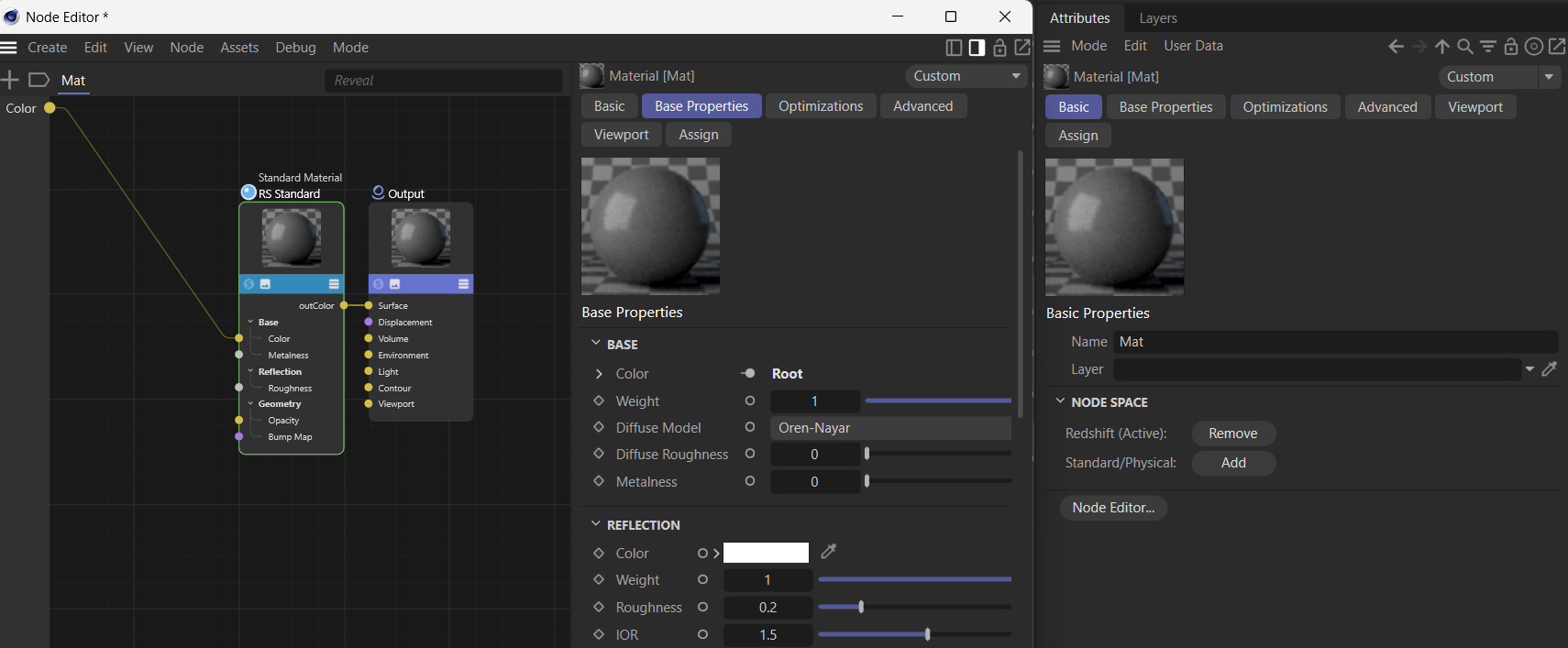
But the Color port in this case does not show up in the AM? I do not think there is a way, at least from a technical perspective, the generic "Standard Material" overrides the whole UI of that material and puts there the end node of the material graph. E.g., as shown below for the Standard Render (and this is then also called 'Inputs').
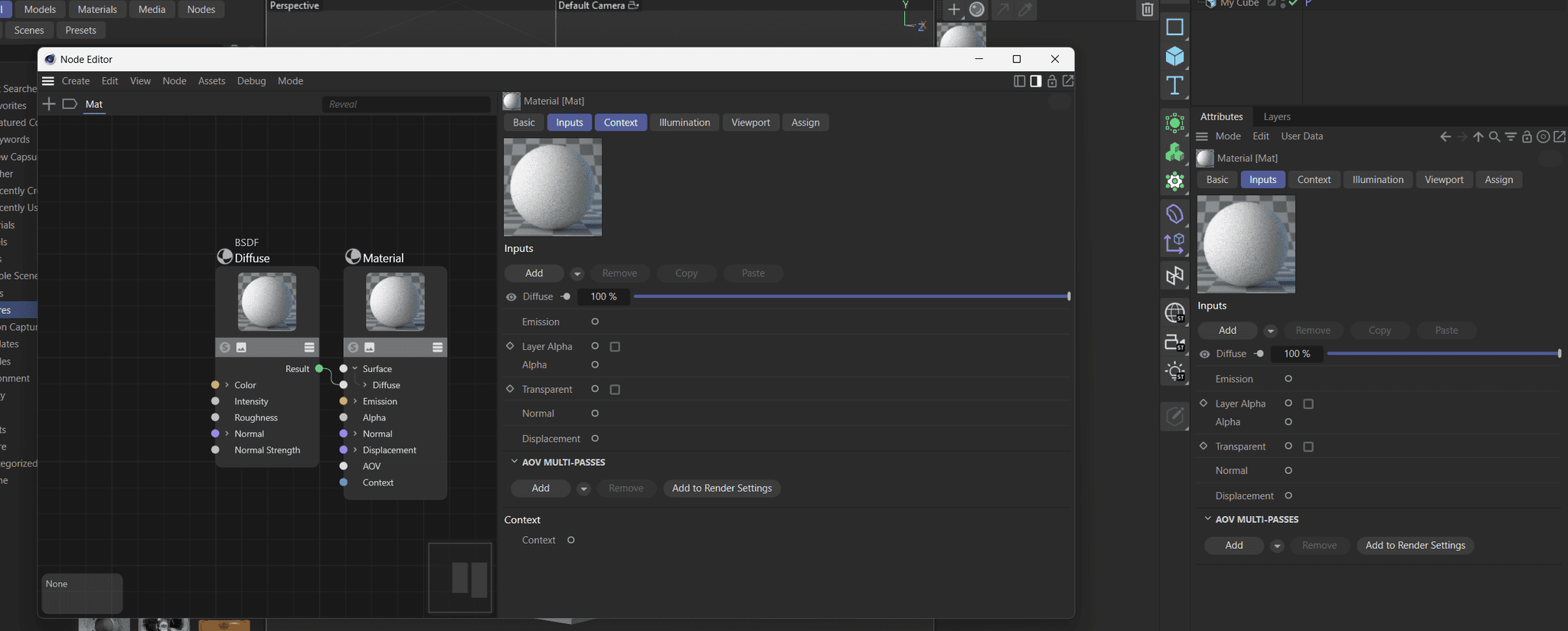
It is only Redshift which overrides this behaviour, and only when you have a RS Standard (or Standard Material) node in the graph, then it will display that. If you do not, it will default to the general material nodes behaviour of displaying the end node.
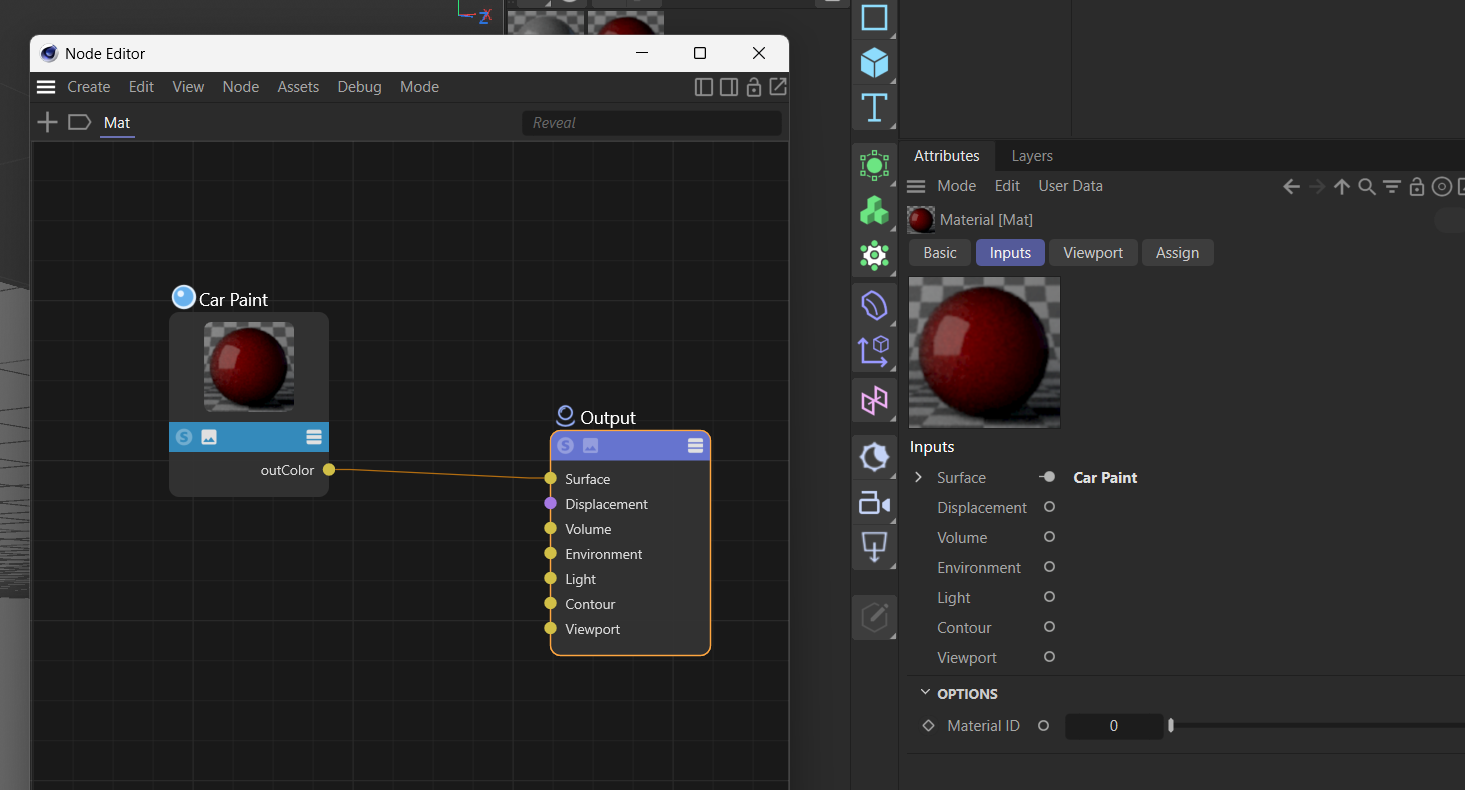
So, I would say this is not possible, and the place to go would be end user support.
Cheers,
Ferdinand
FYI: I also turned off the edit limit for new users of 3600 seconds, I guess the system views you as a new user with 12 postings.
Hey @d_keith,
I am briefly on vacation, so it will probably take a week before I can have a look. But you are in good hands with the rest of the SDK team  But, yes, you should be able to create a repo (i.e., asset database) with
But, yes, you should be able to create a repo (i.e., asset database) with CreateRepositoryFromUrl and when the passed URL already contains a repo, it should not create a new one. That was at least its S26 behavior, it could be that Tilo has changed that since then. If I remember correctly, Daniel reported something similar about that function not respecting existing repos, or at least that it created a database asset each time for being called (not the same as an entire new repo and probably what you mean).
The TLDR aside from the concrete support case is: Please create tickets for bugs, when the documentation says one thing, and the function does another thing, this is at least worthy of being a bug candidate. When this is super urgent for you and Ilia or Maxime do not have an answer right away, you could also ask Tilo or talk with Daniel what he did.
Hey,
Node attributes are things that are directly present on a GraphNode. You could also call them fields, because a GraphNode like many things in our API has qualities of a DataDictionay, i.e., you can write values over keys into it, just like for Python's own dict.
Such node attributes (for true nodes) are then rendered out quite similarly to port values in the Attribute Manager but they are fundamentally different from ports, as users cannot drive their value with a connection, i.e., the value of a port of another node. And a port also always requires another GraphNode attached to the true node¹ for which they are a port, while the attribute sits directly on the true node.
An attribute, e.g., the name of a node, will also never show up in the node representation in the graph. In the screen below I for example right clicked on the RS Reference node and invoked Add Input > All; but things like Name, Color, Show Preview etc. are alle not listed.
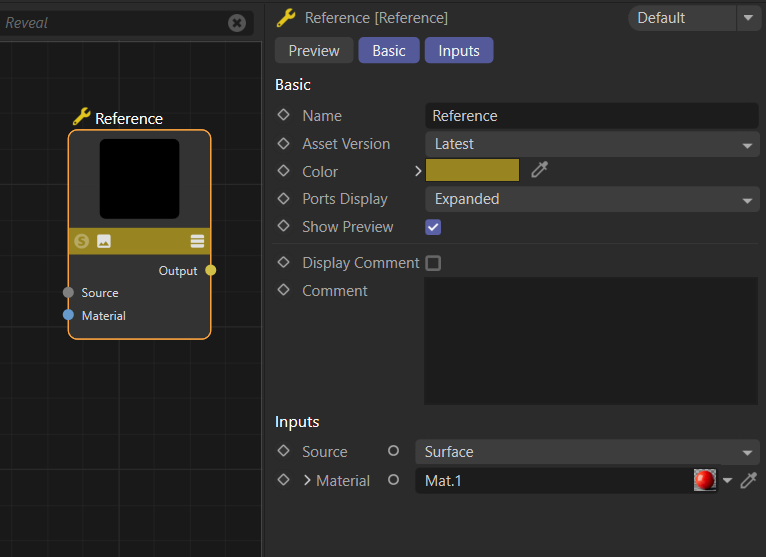
That is because they are all attributes and not ports. There is unfortunately no absolute rule like 'everything in Basic is attributes and everything else is ports'. While it holds (for now) true that everything in Basic is an attribute, especially Redshift also puts attributes into other tabs. They usually only appear in more complex scenarios when dealing with port bundles and variadic ports, but they exist.
And just for clarity, attributes do not only exist on nodes that are what our API calls 'true nodes'¹, but also on other GraphNode types, e.g., a GraphNode representing a port. It is just that they are usually not rendered out to the GUI there and more of an internal nature (nodes have a lot of internal attributes).
Cheers,
Ferdinand
¹ GraphNode instances that represent what the end user would consider a 'node', e.g., the RS Reference node, and with that excluding GraphNode instances that for example represent an input port.
Hey @wen
It should be SetPortValue and not SetValue, my bad. I.e., that is why I pointed out that this is not the same as setting the name of a node (an attribute, i.e., SetValue) but setting the value of a port (SetPortValue). I fixed my example above. But just for clarity, I wrote my code example above blind since I had no executable code. And I still have not since this new code of yours is neither executable for us (it uses numpy and pandas (we will not touch 3rd party lib code) and some excel document).
See create_redshift_nodematerial_2024.py for a general example for how to create RS node materials, including how to set a port to a literal. There are also Graph Descriptions which might make things a bit simpler.
Cheers,
Ferdinand
Hey @wen,
Thank you for reaching out to us. First of all, I assume you are talking about this:
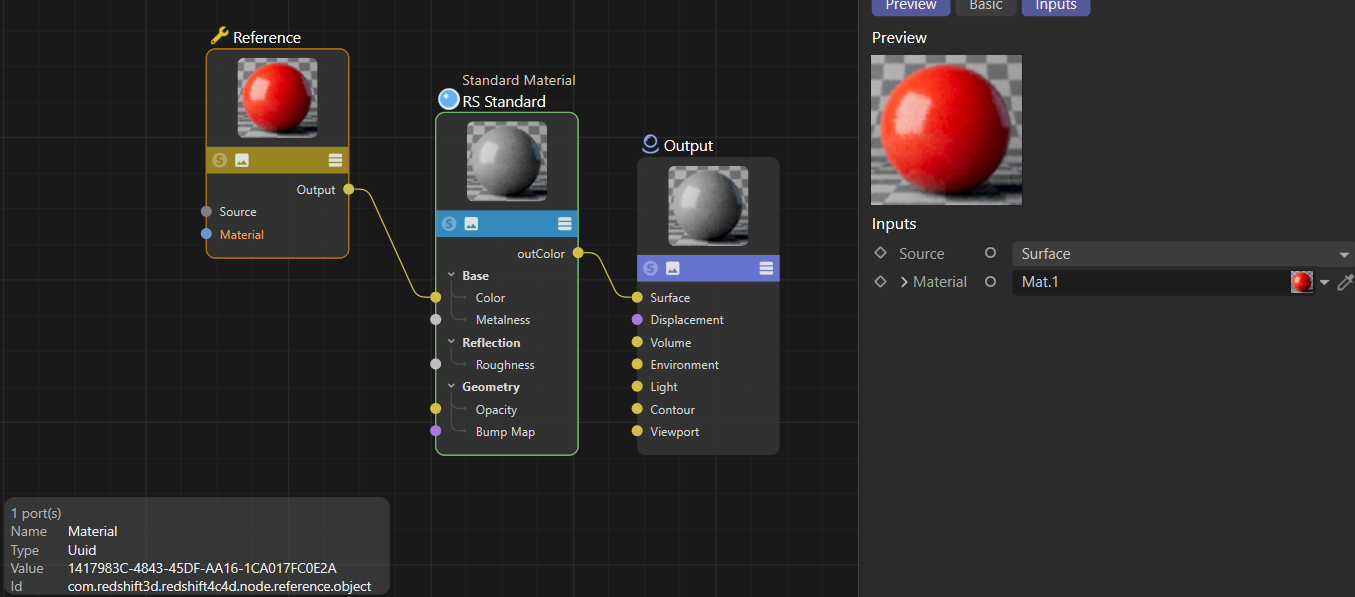
I really struggle to make sense of your code example. I assume what you want to do, is set the value on a 'Material' input port of a Reference node. This is first of all not the same as setting the name of a node (which is an attribute and not a port). And you seem to use there the node template ID of the reference node to try to find the material port (i.e., the type ID of the node, not the ID of the port).
In practice it would go something like this:
referenceNode: maxon.GraphNode # The true node for some RS Reference node.
material: c4d.NodeMaterial # Some RS node material to link/ref.
nimbusRef: maxon.NimbusBaseRef # Some nimbus reference you got hold of somehow.
# The 'Material' input port of #referenceNode.
materialInPort: maxon.GraphNode = referenceNode.GetInputs().FindChild(
"com.redshift3d.redshift4c4d.node.reference.object")
# Set the UUID of #material on the 'Material' input port of the reference node.
materialUuid: maxon.Uuid = nimbusRef.BaseList2DToUuid(material)
materialInPort.SetPortValue(materialUuid)
Cheers,
Ferdinand
Hey @arjo,
There are errors in your console, and they tell you exactly what the issue is. Your steps variable is not an integer and MakePointBuffer expects an integer for its number of points.
Cheers,
Ferdinand
Before
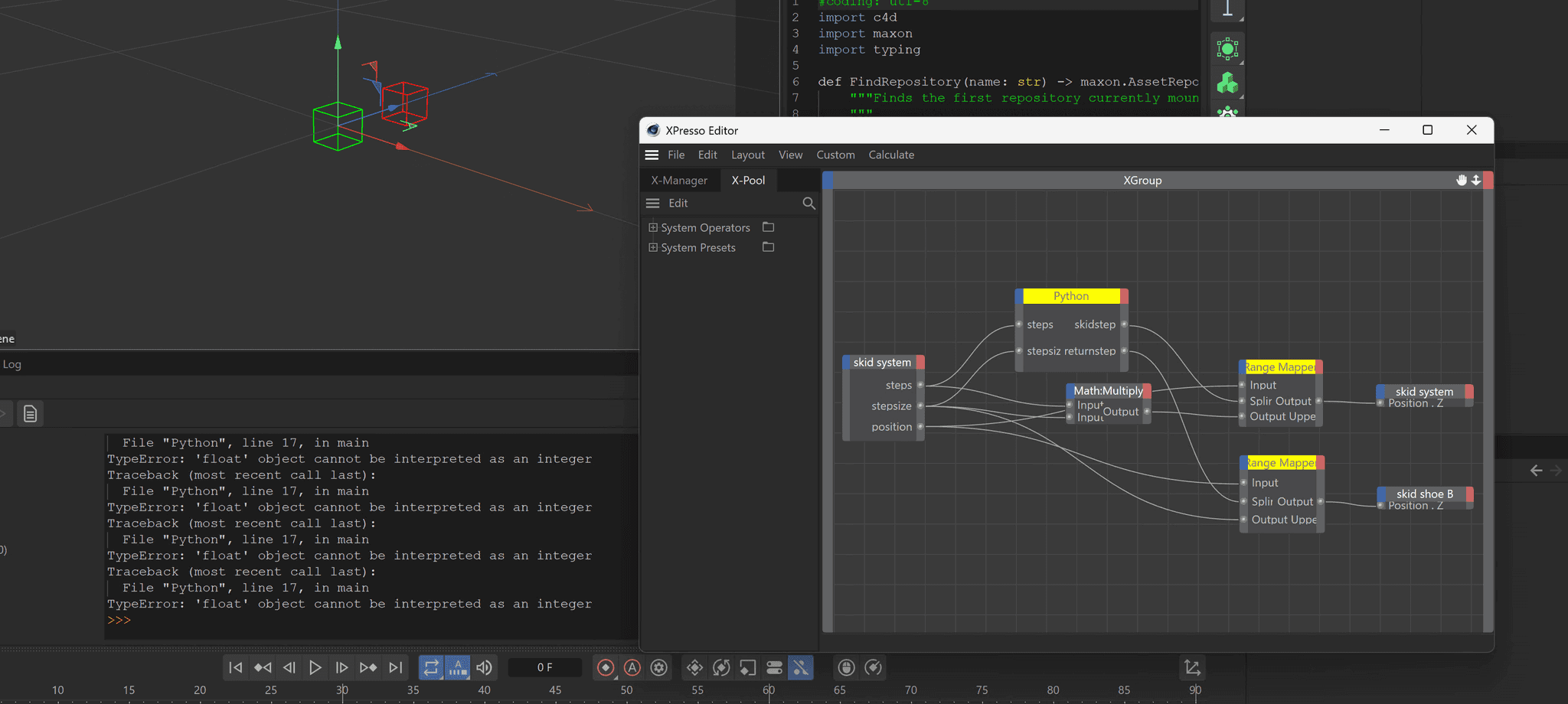
and after, I just cast points to int:
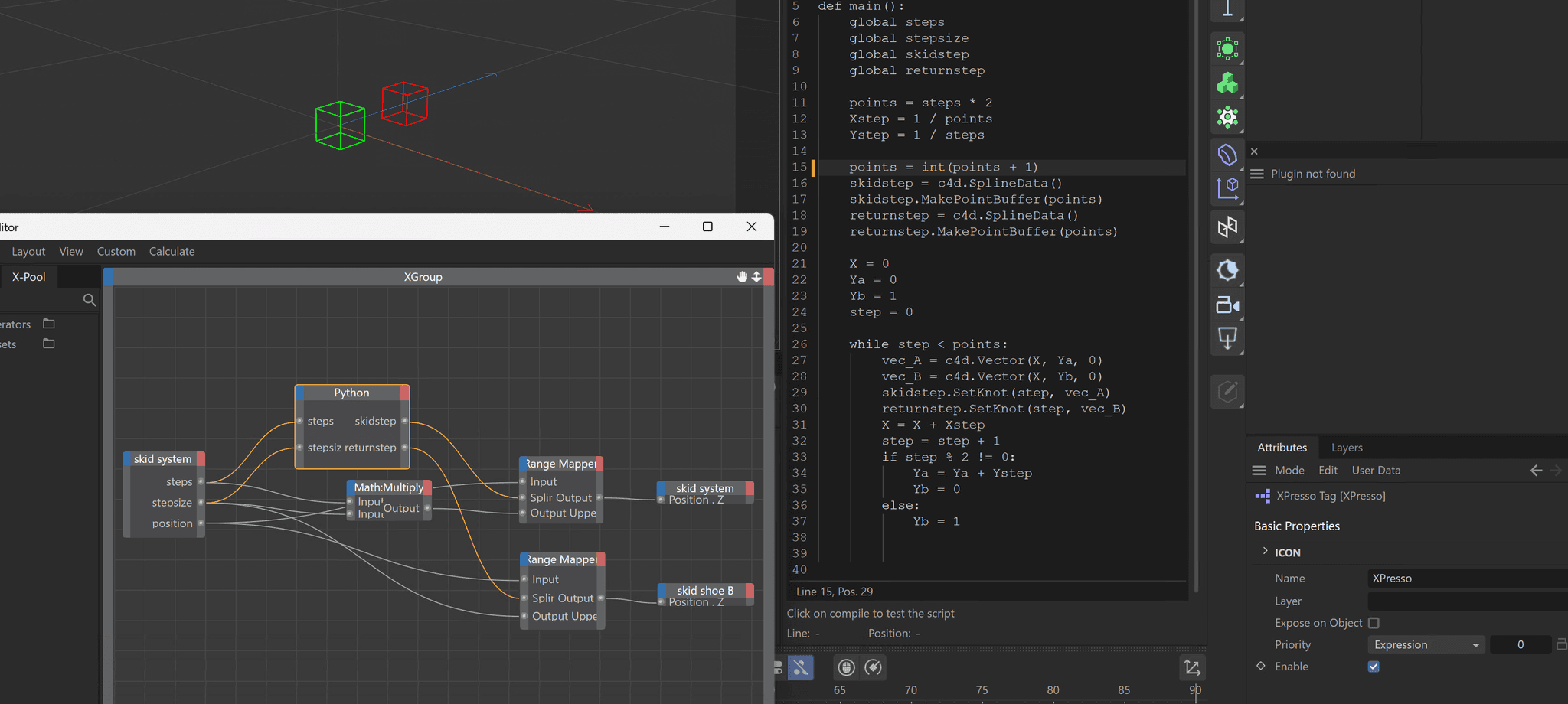
Hello @arjo,
Thank you for reaching out to us. Without your scene file there is not much what we can do for you. That code, at a glance, is correct.
Cheers,
Ferdinand
Hey @T1001,
I am still not 100% sure how you all mean that. But in short what you are doing is not possible in the public API and also only to some degree in the internal API. First of all, Cinema 4D only supports HDR in the viewport and it must be enabled by the user:
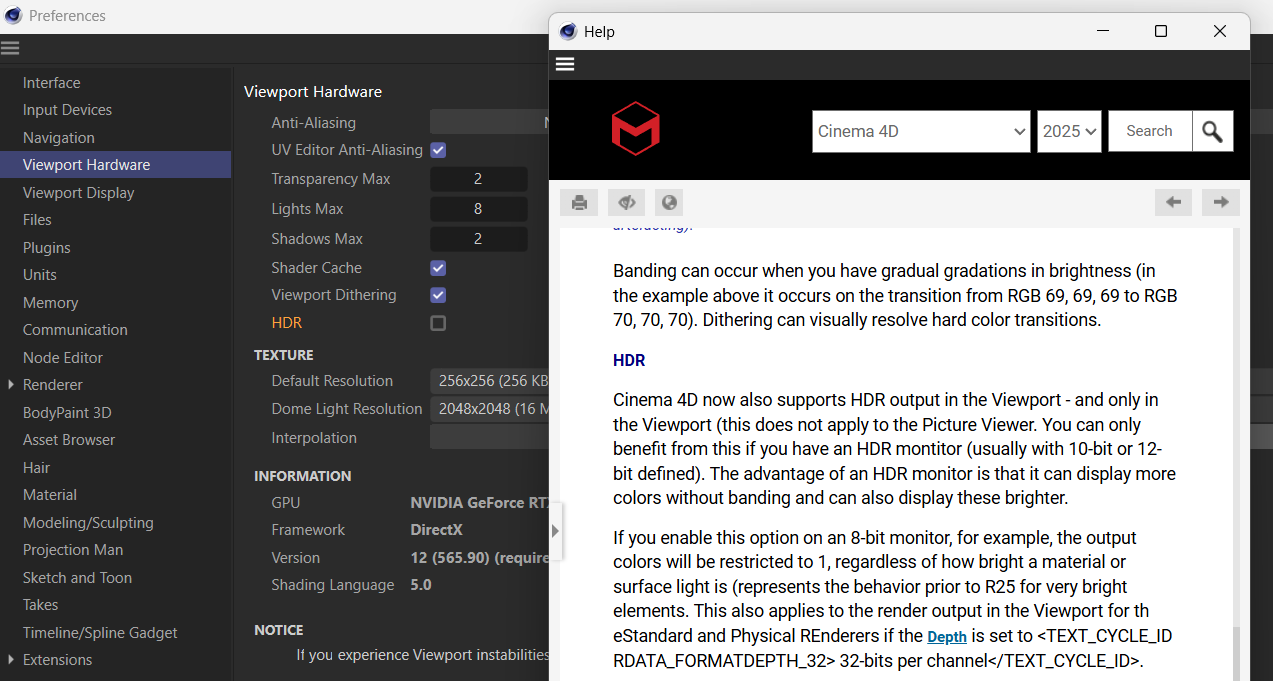
I.e., viewport effectively means Drawport API. What the docs write there about the only the viewport is only semi true, because you can embed a drawport into a GeDialog (but that functionality is still not even semi-public I think, but we could change that in a future release).
I am not quite sure what you mean by 'integrating a custom OpenGL pipeline into a plugin'. When I take this at face value, I would say you cannot do this. The Drawport API is an abstraction around effectively Vulkan and Metal. We do not write OS specific graphics API code anymore. This goes as far as that we have (sort of) our own shading language (MSL). You cannot just draw with OpenGL into a GeDialog, because that dialog will not be drawn with OpenGL and we also do not offer a direct access point to drawing handlers.
I assume this all has something to do with implementing some kind of render buffer? I really would recommend then applying for the Maxon Registered Developer program to get access to the Drawport API. Just as a warning ahead, the Drawport API is not totally undocumented but not documented to the same degree as our fully public API. It is an API from graphics API experts for graphics API experts. You seem fairly knowledgeable there, so this might be just your thing, but you have been warned, there will be less hand-holding there.
Cheers,
Ferdinand